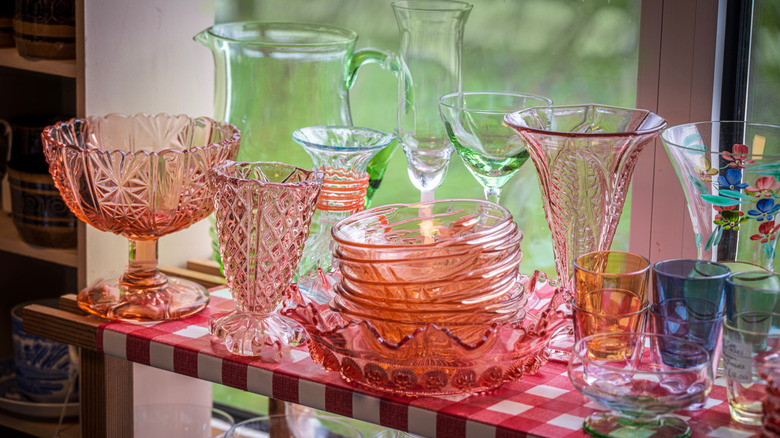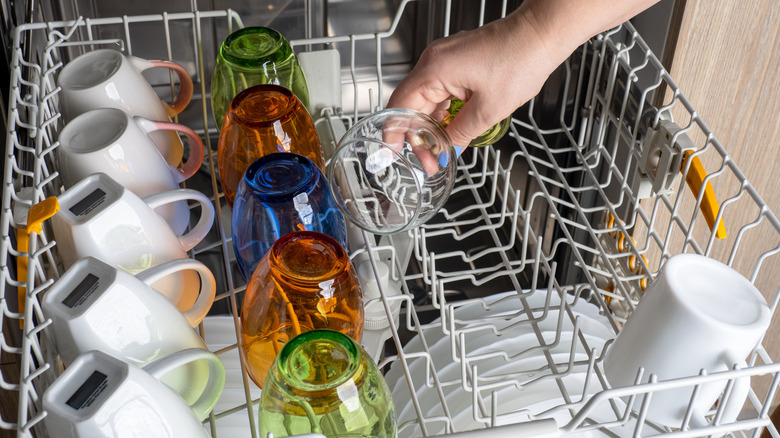On The Hunt For Colored Glassware? Why You Should Check The Thrift Store
Colored glass makes for the most magical, whimsical decor or dinnerware. The starkness of clear crystal is replaced by the warmth and fantasy of ambers, rubies, pinks, greens, and blues refracting light in all directions. Still, not all colored glass is the same, and some may even be considered a bad investment. Looking for vintage glassware at the thrift store can be the key to finding great, durable, and affordable colored pieces that won't start peeling the second you wash them.
Vintage glass is its own unique universe, with centuries of history and countless brands and patterns to wade through. To find beautiful vintage glass that is also safe to drink from, however, there are only a couple of things you need to know. The first is that, unless using it for decor, it's best to steer clear of colored glass made before the 1970s. The use of the toxic metal lead in the production of these pieces was not sufficiently regulated up to that time, and could be dangerous when in contact with food. After you assess the age of that colored vintage glass you've been eyeing at the thrift (most will be marked), carry out a simple scan to determine which technique was used to give it color. From flashed, stained, and cased to true colored glass, knowing the difference will inform you of how durable a given piece is and how it should be cared for.
Understanding the different types of colored glass
True colored glass, or the type of glass where the pigment is added to the material in its molten stage, is the most expensive kind, which is why buying second-hand is a smart move. If you find cheap colored glass on the shelves of large-scale retailers, chances are these pieces are either stained or flashed. In both of these processes, albeit achieved differently and with varying degrees of durability, the color is layered over a clear glass base.
Staining is the cheapest method. It's achieved by painting or spraying the clear glass and then firing it in a kiln to fix the color. Pieces with intricate designs or patterns follow this same technique. Flashing is more complex, somewhat more durable, and more costly. It consists of dipping a piece of clear glass into molten colored glass before blowing, which creates a thin colorful outer layer that may give the illusion of true colored glass.
Cased glass, also known as plated, is similar to flashed, only the outer layer is as thick as the base layer. The outer layer is often cut during the glass-making process to reveal the inner layer, which can be clear or in a different color. To attain a multi-colored piece, multiple layers are added. Because of the elaborateness of this process, cased glass is just as, if not more expensive than true colored glass, and its color is just as durable.
How to identify and care for your colored glass
When scratched or worn, both stained and flashed glass will reveal the clear glass underneath the colorful layer, so look out for signs of abrasion. The more consistent and smooth the color in the glass is, the more likely it is to be true colored glass. Similarly, if you can see a thick layer of clear glass in the rim, you're looking at stained or flashed. With cased glass, you'll notice multiple layers of similar thickness.
While all glass is prone to clouding and color change after multiple washes, stained and flashed are the kind of vintage glassware you should never put in the dishwasher. The outer layer will flake off from the harsh detergents and water sprays.
With homeware brands always looking to cut costs, the resale market may be your best shot at finding true colored or cased glass for friendly prices. Yes, the color in these pieces is much more durable than the alternative, but adequate cleaning practices are still recommended to further lengthen its lifespan. Hand-wash with mild detergent, warm water, and a soft sponge only.


